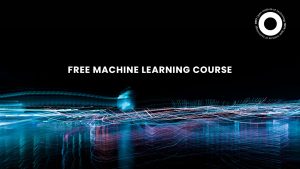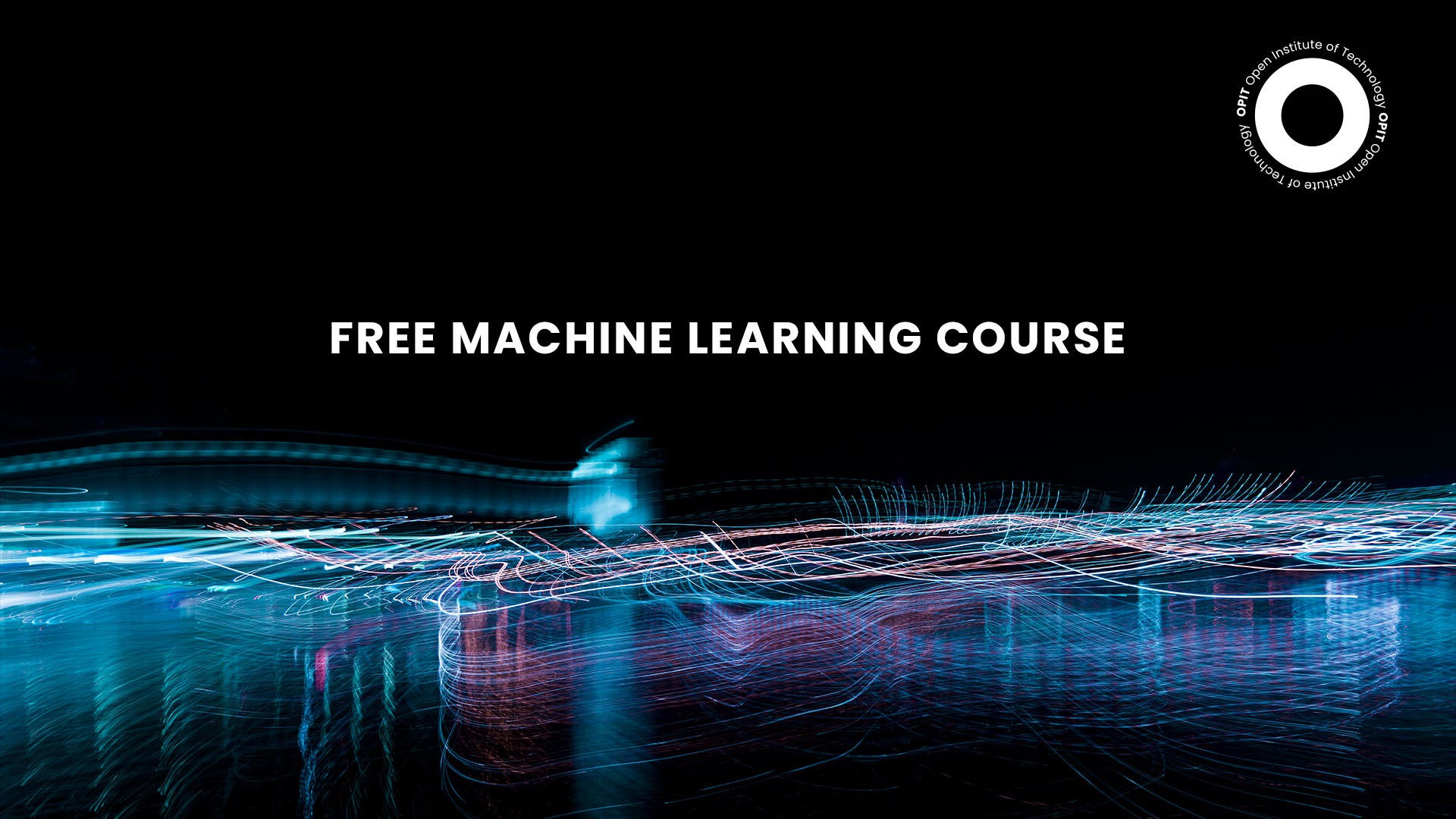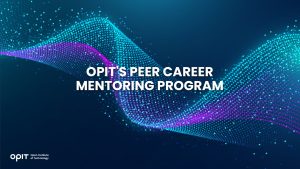

Did you know that machines can learn, too, similarly to humans?
In machine learning, software applications can be trained to parse data, learn from it, and then make informed decisions based on their findings. This outcome prediction has proven to be invaluable in numerous industries, including IT (malware threat detection), healthcare (disease diagnosis and prognosis), manufacturing (business process automation), and finance (fraud detection).
The importance of machine learning in today’s technology-driven world can’t be understated. So, if you’re considering a career in data science, software engineering, or artificial intelligence (AI), this is the skill to learn.
Fortunately, learning this skill is now accessible to almost anyone. Just go online and find a machine learning course for beginners.
We’ve gathered our three favorites to help you narrow your search (and avoid wasting time on subpar courses). We aim to make it easy to select the perfect free machine learning course and crush it online.
Criteria for Selecting the Top Beginner-Friendly Online Picks
The internet offers seemingly endless learning resources. This is undoubtedly great news, as it levels the playing field for eager learners worldwide. But be careful; not all online resources will be valuable to you. Some will just waste your time.
So, how can you comb through the sea of content and find a course worth pursuing? By knowing precisely what you’re looking for, of course. Check out our selection criteria to track down a great online course.
Course Content and Structure
Most courses you find online will come with a description. The more detailed it is, the better. By carefully reading the description, you’ll better understand what the course covers and how it is structured.
These descriptions can sometimes read fluffy to get as many learners to apply. But try to look past the buzzwords and extract only the essential information – what the syllabus looks like, how many hours it takes to complete the course, and how the lessons are spaced.
If there are video lessons, check previews to ensure you’ll only work with high-quality video and audio outputs throughout the course.
Instructor Expertise and Teaching Style
If the course’s content is sound, it’s time to move on to the person (or people) who will present it to you. After all, anyone can read a bunch of words from a book. It takes an experienced and knowledgeable instructor to help you truly understand the learning material.
So, before signing up for the course, do a little research on the instructor. Check out their bio to learn about their expertise and experience in the field.
Beyond that, play a lecture or two to ensure their teaching style suits you. Having issues with the little things like their voice or body language can impact your concentration and, in turn, your success.
Platform Features and User Experience
Now that we’ve covered what you’re learning and who you’re learning it from, the only question is where the learning will take place.
Take a more in-depth look at the platform hosting your chosen course. Ensure it offers a seamless user experience, as glitches and downtime aren’t exactly ideal for a learning environment.
Also, the more exciting features the platform has, the easier it will be to stick to the course. Different learning material formats, interactive elements, discussion forums, and progress tracking are just some of the features that can significantly improve your learning experience.
Community Support and Resources
The lack of personal interaction in online learning can make you feel like you’re all alone. This can be incredibly challenging if you’re struggling with a lesson or a part of the course. So, when looking for the perfect online class, ensure you’ll get a chance to interact with other learners or even experts in the field.
Asking questions, sharing insights, collecting feedback, and receiving support and motivation should be a part of every learner’s journey.
Cost and Accessibility
If your chosen course checks all your boxes, don’t celebrate just yet. First, check whether you can access it and how much it costs.
Access can sometimes be limited by your country or device, so make sure nothing stands between you and learning online.
As for the cost, you’ll find plenty of high-quality courses free of charge. If there is a fee to pay, check whether you can purchase just the individual class or you have to subscribe to the platform. The latter approach is better for those who want to acquire multiple skills and work on their education long-term.
Top Beginner-Friendly Online Picks for Free Machine Learning Courses
Here are the top three beginner-friendly machine learning courses we’ve chosen based on the selection criteria above. Each one should help you learn the fundamentals of this field and how to use machine learning effectively as a skill.
Supervised Machine Learning: Regression and Classification by Andrew Ng
If you want to learn more about machine learning, why not consult one of its leading figures? That’s what you can do if you take this course. You’ll learn from Andrew Ng, a prominent computer scientist and a pioneer in machine learning and AI. All things considered, it’s no wonder this is probably the most popular free machine learning course online.
During this course, you’ll master the key concepts of machine learning (supervised and unsupervised learning and best practices) and learn how to apply them in practice. Some of the skills you’ll gain include:
- Linear regression
- Logistic regression for classification
- Gradient descent
- Regularization to avoid overfitting
This is one of the best beginner courses for entering the machine learning field. It offers abundant knowledge, a flexible schedule, and resettable deadlines. The only downside is that you must enroll in the entire specialization to receive a certificate upon completion.
Machine Learning Crash Course by Google
Google is a major disruptor in the AI industry. So, a free machine learning course offered by this tech giant is seriously a big deal. As the name suggests, this is a crash course, so expect a fast-paced and intense approach to machine learning.
Throughout 25 lessons, you’ll learn about specific machine-learning areas through video lectures from Google researchers, real-world case studies, written guides, and hands-on exercises.
The key topics this course covers include:
- A deep dive into neural networks
- The inner workings of gradient descent
- Model training and evaluation
- The importance of loss functions
The course is relatively short (15 hours) yet informative, so it can be an excellent choice for those pursuing machine learning while having a job. However, if you’re an absolute beginner, you’ll have to do some reading before starting the course, which some may view as a downside.
Practical Machine Learning With Scikit-Learn by Adam Eubanks
If you’re looking for something even shorter than Google’s Crash Course, you’ll love this course on Udemy. You’ll learn the most powerful machine-learning algorithms in a little over an hour. This course focuses on Scikit-Learn, a Python machine-learning library ideal for beginners.
Here are some of the algorithms this course covers:
- Linear regression
- Polynomial regression
- Multiple linear regression
- Logistic regression
- Support vector machines
- Decision trees
This is the perfect course for kick-starting your machine-learning journey. However, some learners might find it too limited in scope. Also, the course lacks interaction with the instructor, which might be a deal breaker for some learners.
Tips for Success in Learning Machine Learning Online
Imagine going through all the trouble of finding the perfect machine learning free online course, only to abandon it halfway through. There’s no judgment here, of course. We know how difficult it can be to persevere with learning outside the traditional classroom and school system.
So, here are some tips to help you complete a machine learning course for beginners triumphantly:
- Set clear goals and expectations. Before starting the course, remind yourself of why you’re doing it and how it fits your career development. Don’t just buy the course for the sake of buying it; these impulse purchases rarely translate to success.
- Dedicate consistent time for learning. Like with many things in life, consistency is key. But this time, there’s no one to keep you on track besides yourself. So, work on your self-discipline and commit to regular study sessions.
- Engage with the community and seek help when needed. Online learning can feel like an isolating experience. But it doesn’t have to, provided you’ve selected the right platform. If you ever feel stuck, don’t hesitate to seek help from the community. These simple interactions will help you stay motivated and focused.
- Apply learned concepts to real-world projects. As soon as you gain a fundamental understanding of machine learning, try to put this knowledge to practice. Seeing how the theory you’re learning sets you up for success is a great incentive to keep learning.
- Continuously update skills and knowledge. Are you done with the machine learning course for beginners? Great, it’s time to look for a more advanced one. Continuously learning and improving your skills is the only way to stay on top.
Considerable Knowledge at No Cost
You won’t make a mistake regardless of whether you put your trust in Andrew Ng or Adam Eubanks or go the Google route. What you will do is gain valuable knowledge about an even more valuable skill: machine learning.
If you want to master your knowledge of machine learning, consider pursuing a Bachelor’s degree in Modern Computer Science from the Open Institute of Technology. The syllabus includes two courses focusing on machine learning and numerous others that will skyrocket your career opportunities.
Related posts

Source:
- Raconteur, published on November 06th, 2025
Many firms have conducted successful Artificial Intelligence (AI) pilot projects, but scaling them across departments and workflows remains a challenge. Inference costs, data silos, talent gaps and poor alignment with business strategy are just some of the issues that leave organisations trapped in pilot purgatory. This inability to scale successful experiments means AI’s potential for improving enterprise efficiency, decision-making and innovation isn’t fully realised. So what’s the solution?
Although it’s not a magic bullet, an AI operating model is really the foundation for scaling pilot projects up to enterprise-wide deployments. Essentially it’s a structured framework that defines how the organisation develops, deploys and governs AI. By bringing together infrastructure, data, people, and governance in a flexible and secure way, it ensures that AI delivers value at scale while remaining ethical and compliant.
“A successful AI proof-of-concept is like building a single race car that can go fast,” says Professor Yu Xiong, chair of business analytics at the UK-based Surrey Business School. “An efficient AI technology operations model, however, is the entire system – the processes, tools, and team structures – for continuously manufacturing, maintaining, and safely operating an entire fleet of cars.”
But while the importance of this framework is clear, how should enterprises establish and embed it?
“It begins with a clear strategy that defines objectives, desired outcomes, and measurable success criteria, such as model performance, bias detection, and regulatory compliance metrics,” says Professor Azadeh Haratiannezhadi, co-founder of generative AI company Taktify and professor of generative AI in cybersecurity at OPIT – the Open Institute of Technology.
Platforms, tools and MLOps pipelines that enable models to be deployed, monitored and scaled in a safe and efficient way are also essential in practical terms.
“Tools and infrastructure must also be selected with transparency, cost, and governance in mind,” says Efrain Ruh, continental chief technology officer for Europe at Digitate. “Crucially, organisations need to continuously monitor the evolving AI landscape and adapt their models to new capabilities and market offerings.”
An open approach
The most effective AI operating models are also founded on openness, interoperability and modularity. Open source platforms and tools provide greater control over data, deployment environments and costs, for example. These characteristics can help enterprises to avoid vendor lock-in, successfully align AI to business culture and values, and embed it safely into cross-department workflows.
“Modularity and platformisation…avoids building isolated ‘silos’ for each project,” explains professor Xiong. “Instead, it provides a shared, reusable ‘AI platform’ that integrates toolchains for data preparation, model training, deployment, monitoring, and retraining. This drastically improves efficiency and reduces the cost of redundant work.”
A strong data strategy is equally vital for ensuring high-quality performance and reducing bias. Ideally, the AI operating model should be cloud and LLM agnostic too.
“This allows organisations to coordinate and orchestrate AI agents from various sources, whether that’s internal or 3rd party,” says Babak Hodjat, global chief technology officer of AI at Cognizant. “The interoperability also means businesses can adopt an agile iterative process for AI projects that is guided by measuring efficiency, productivity, and quality gains, while guaranteeing trust and safety are built into all elements of design and implementation.”
A robust AI operating model should feature clear objectives for compliance, security and data privacy, as well as accountability structures. Richard Corbridge, chief information officer of Segro, advises organisations to: “Start small with well-scoped pilots that solve real pain points, then bake in repeatable patterns, data contracts, test harnesses, explainability checks and rollback plans, so learning can be scaled without multiplying risk. If you don’t codify how models are approved, deployed, monitored and retired, you won’t get past pilot purgatory.”
Of course, technology alone can’t drive successful AI adoption at scale: the right skills and culture are also essential for embedding AI across the enterprise.
“Multidisciplinary teams that combine technical expertise in AI, security, and governance with deep business knowledge create a foundation for sustainable adoption,” says Professor Haratiannezhadi. “Ongoing training ensures staff acquire advanced AI skills while understanding associated risks and responsibilities.”
Ultimately, an AI operating model is the playbook that enables an enterprise to use AI responsibly and effectively at scale. By drawing together governance, technological infrastructure, cultural change and open collaboration, it supports the shift from isolated experiments to the kind of sustainable AI capability that can drive competitive advantage.
In other words, it’s the foundation for turning ambition into reality, and finally escaping pilot purgatory for good.

The Open Institute of Technology (OPIT) is the perfect place for those looking to master the core skills and gain the fundamental knowledge they need to enter the exciting and dynamic environment of the tech industry. While OPIT’s various degrees and courses unlock the doors to numerous careers, students may not know exactly which line of work they wish to enter, or how, exactly, to take the next steps.
That’s why, as well as providing exceptional online education in fields like Responsible AI, Computer Science, and Digital Business, OPIT also offers an array of career-related services, like the Peer Career Mentoring Program. Designed to provide the expert advice and support students need, this program helps students and alumni gain inspiration and insight to map out their future careers.
Introducing the OPIT Peer Career Mentoring Program
As the name implies, OPIT’s Peer Career Mentoring Program is about connecting students and alumni with experienced peers to provide insights, guidance, and mentorship and support their next steps on both a personal and professional level.
It provides a highly supportive and empowering space in which current and former learners can receive career-related advice and guidance, harnessing the rich and varied experiences of the OPIT community to accelerate growth and development.
Meet the Mentors
Plenty of experienced, expert mentors have already signed up to play their part in the Peer Career Mentoring Program at OPIT. They include managers, analysts, researchers, and more, all ready and eager to share the benefits of their experience and their unique perspectives on the tech industry, careers in tech, and the educational experience at OPIT.
Examples include:
- Marco Lorenzi: Having graduated from the MSc in Applied Data Science and AI program at OPIT, Marco has since progressed to a role as a Prompt Engineer at RWS Group and is passionate about supporting younger learners as they take their first steps into the workforce or seek career evolution.
- Antonio Amendolagine: Antonio graduated from the OPIT MSc in Applied Data Science and AI and currently works as a Product Marketing and CRM Manager with MER MEC SpA, focusing on international B2B businesses. Like other mentors in the program, he enjoys helping students feel more confident about achieving their future aims.
- Asya Mantovani: Asya took the MSc in Responsible AI program at OPIT before taking the next steps in her career as a Software Engineer with Accenture, one of the largest IT companies in the world, and a trusted partner of the institute. With a firm belief in knowledge-sharing and mutual support, she’s eager to help students progress and succeed.
The Value of the Peer Mentoring Program
The OPIT Peer Career Mentoring Program is an invaluable source of support, inspiration, motivation, and guidance for the many students and graduates of OPIT who feel the need for a helping hand or guiding light to help them find the way or make the right decisions moving forward. It’s a program built around the sharing of wisdom, skills, and insights, designed to empower all who take part.
Every student is different. Some have very clear, fixed, and firm objectives in mind for their futures. Others may have a slightly more vague outline of where they want to go and what they want to do. Others live more in the moment, focusing purely on the here and now, but not thinking too far ahead. All of these different types of people may need guidance and support from time to time, and peer mentoring provides that.
This program is also just one of many ways in which OPIT bridges the gaps between learners around the world, creating a whole community of students and educators, linked together by their shared passions for technology and development. So, even though you may study remotely at OPIT, you never need to feel alone or isolated from your peers.
Additional Career Services Offered by OPIT
The Peer Career Mentoring Program is just one part of the larger array of career services that students enjoy at the Open Institute of Technology.
- Career Coaching and Support: Students can schedule one-to-one sessions with the institute’s experts to receive insightful feedback, flexibly customized to their exact needs and situation. They can request resume audits, hone their interview skills, and develop action plans for the future, all with the help of experienced, expert coaches.
- Resource Hub: Maybe you need help differentiating between various career paths, or seeing where your degree might take you. Or you need a bit of assistance in handling the challenges of the job-hunting process. Either way, the OPIT Resource Hub contains the in-depth guides you need to get ahead and gain practical skills to confidently move forward.
- Career Events: Regularly, OPIT hosts online career event sessions with industry experts and leaders as guest speakers about the topics that most interest today’s tech students and graduates. You can join workshops to sharpen your skills and become a better prospect in the job market, or just listen to the lessons and insights of the pros.
- Internship Opportunities: There are few better ways to begin your professional journey than an internship at a top-tier company. OPIT unlocks the doors to numerous internship roles with trusted institute partners, as well as additional professional and project opportunities where you can get hands-on work experience at a high level.
In addition to the above, OPIT also teams up with an array of leading organizations around the world, including some of the biggest names, including AWS, Accenture, and Hype. Through this network of trust, OPIT facilitates students’ steps into the world of work.
Start Your Study Journey Today
As well as the Peer Career Mentoring Program, OPIT provides numerous other exciting advantages for those who enroll, including progressive assessments, round-the-clock support, affordable rates, and a team of international professors from top universities with real-world experience in technology. In short, it’s the perfect place to push forward and get the knowledge you need to succeed.
So, if you’re eager to become a tech leader of tomorrow, learn more about OPIT today.
Have questions?
Visit our FAQ page or get in touch with us!
Write us at +39 335 576 0263
Get in touch at hello@opit.com
Talk to one of our Study Advisors
We are international
We can speak in:


